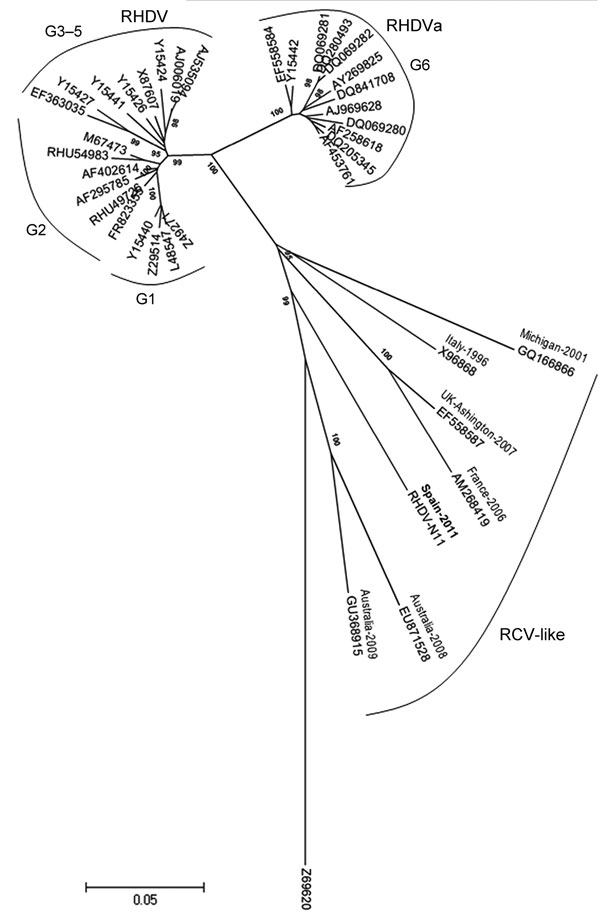Volume 18, Number 12—December 2012
Dispatch
Variant Rabbit Hemorrhagic Disease Virus in Young Rabbits, Spain
Figure 1

Figure 1. . Evolutionary relationships of rabbit hemorrhagic disease virus (RHDV) and related viruses. A total of 38 nt sequences were analyzed: the isolate from this study, designated RHDV-N11 (GenBank accession no. JX133161); 18 classical RHDV and 12 RHDVa isolates; 6 rabbit calicivirus (RCV)–like isolates; and European brown hare syndrome virus (GenBank accession no. Z69620) as an outlier. Evolutionary history was inferred by using the neighbor-joining method; optimal tree with the sum of branch length = 1.33075964 is shown. The tree is drawn to scale, with branch lengths in the same units as those of the evolutionary distances used to infer the phylogenetic tree. Evolutionary distances were computed by using the p-distance method (14) and are in the units of the number of base differences per site. Codon positions included were 1st + 2nd + 3rd + Noncoding. All ambiguous positions were removed for each sequence pair; the final dataset consisted of 646 positions. Evolutionary analyses were conducted in MEGA5 (15). RHDV genetic groups are indicated. GenBank accession numbers of the sequences were: RCV-like strains: EU871528, GU368915, X96868, EF558587, AM268419, GQ166866; RHDV strains; AJ006019, AJ535094, Y15424, Y15426, Y15441, EF363035, Y15427, AF402614, RHU54983, AF295785, Z49271, L48547, Y15440, RHU49726, Z29514, M67473, X87607, FR823355; RHDVa strains: DQ069280, DQ280493, DQ069282, AY269825, DQ841708, DQ205345, AF258618, DQ069281, AJ969628, AF453761, EF558584, Y15442.
References
- World Organisation for Animal Health. Terrestrial manual. Chapter 2.6.2. Rabbit haemorrhagic disease. 2010 [cited 2012 Feb 27]. http://www.oie.int/fileadmin/Home/eng/Health_standards/tahm/2.06.02_RHD.pdf
- Mikami O, Kimura T, Ochiai K, Itakura C. Hepatic lesions in young rabbits experimentally infected with rabbit haemorrhagic disease virus. Res Vet Sci. 1999;66:237–42. DOIPubMedGoogle Scholar
- Ruvoën-Clouet N, Ganière JP, André-Fontaine G, Blanchard D, Le Pendu J. Binding of rabbit hemorrhagic disease virus to antigens of the ABH histo-blood group family. J Virol. 2000;74:11950–4. DOIPubMedGoogle Scholar
- Parra F, Prieto M. Purification and characterization of a calicivirus as the causative agent of a lethal hemorrhagic disease in rabbits. J Virol. 1990;64:4013–5.PubMedGoogle Scholar
- Capucci L, Fusi P, Lavazza A, Lodovica Pacciarini M, Rossi C. Detection and preliminary characterization of a new rabbit calicivirus related to rabbit hemorrhagic disease virus but nonpathogenic. J Virol. 1996;70:8614–23.PubMedGoogle Scholar
- Kerr PJ, Kitchen A, Holmes EC. Origin and phylodynamics of rabbit hemorrhagic disease virus. J Virol. 2009;83:12129–38. DOIPubMedGoogle Scholar
- Bergin IL, Wise AG, Bolin SR, Thomas P, Mullaney TP, Kiupel M, Novel calicivirus identified in rabbits, Michigan, USA. Emerg Infect Dis. 2009;15:1955–62. DOIPubMedGoogle Scholar
- Le Gall-Reculé G, Zwingelstein F, Boucher S, Le Normand B, Plassiart G, Portejoie Y, Detection of a new variant of rabbit haemorrhagic disease virus in France. Vet Rec. 2011;168:137–8. DOIPubMedGoogle Scholar
- Le Gall-Reculé G, Zwingelstein F, Fages M-P, Bertagnoli S, Gelfi J, Aubineau J, Characterisation of a non-pathogenic and non-protective infectious rabbit lagovirus related to RHDV. Virology. 2011;410:395–402. DOIPubMedGoogle Scholar
- Muller A, Freitas J, Silva E, Le Gall-Recule G, Zwingelstein F, Abrantes J, Evolution of rabbit haemorrhagic disease virus (RHDV) in the European rabbit (Oryctolagus cuniculus) from the Iberian Peninsula. Vet Microbiol. 2009;135:368–73. DOIPubMedGoogle Scholar
- Neill JD. Nucleotide sequence of the capsid protein gene of two serotypes of San Miguel sea lion virus: identification of conserved and non-conserved amino acid sequences among calicivirus capsid proteins. Virus Res. 1992;24:211–22. DOIPubMedGoogle Scholar
- Capucci L, Frigoli G, Ronshold L, Lavazza A, Brocchi E, Rossi C. Antigenicity of the rabbit hemorrhagic disease virus studied by its reactivity with monoclonal antibodies. Virus Res. 1995;37:221–38. DOIPubMedGoogle Scholar
- Nyström K, Le Gall-Recule G, Grassi P, Abrantes J, Ruvoen-Clouet N, Le Moullac-Vaidye B, Histo-blood group antigens act as attachment factors of rabbit hemorrhagic disease virus infection in a virus strain-dependent manner. PLoS Pathog. 2011;7:e1002188. DOIPubMedGoogle Scholar
- Nei M, Kumar S. Molecular evolution and phylogenetics. New York: Oxford University Press; 2000.
- Tamura K, Peterson D, Peterson N, Stecher G, Nei M, Kumar S. MEGA5: molecular evolutionary genetics analysis using maximum likelihood, evolutionary distance, and maximum parsimony methods. Mol Biol Evol. 2011;28:2731–9. DOIPubMedGoogle Scholar